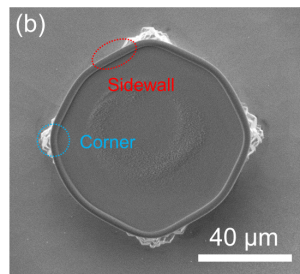Optical input control using an octagonal toroidal resonator
Research
Optical input control using an octagonal toroidal resonator
Toward stabilization of optical input in micro optical resonators
In our previous work, we proposed a method to control optical input by shaping a micro optical resonator into an octagonal shape using FDTD analysis. In this study, we experimentally confirmed this proposal and showed that the optical input can be controlled by designing the shape of the resonator.

Figure 1: (a) Calculated strength of optical coupling using coupled mode theory.

(b) Electron micrograph of an octagonal toroidal resonator
The silicatroid micro optical resonator used in this research is called a whispering gallery resonator, in which a thin optical fiber with a diameter of 1-2 μm is brought close to the resonator to provide near-field optical input. Although this method enables highly efficient light input, it has the disadvantage of being vulnerable to mechanical vibration because of the need for minute control of spatial positioning (sub-micrometer). Therefore, we designed and fabricated a resonator to achieve optimum efficiency even when the mechanically stable resonator and optical fiber are in contact. The results are shown in Figure 1. (The horizontal axis represents the distance between the resonator and the optical fiber (0 nm is the contact state), and the vertical axis represents the strength of light coupling (input) (the smaller the value, the stronger the coupling). This shows that the strength of the coupling varies depending on the position of the light input.
Figure 2 shows the measurement results for an octagonal toroidal resonator. The horizontal axis is the distance between the resonator and the optical fiber, and the vertical axis shows how much light is input (smaller values are optimal). The results show that the light input differs between the edges (red) and the corners (light blue), and that the optimal input can be achieved by using the edges. From these results, we have proposed a method to stabilize the optical input for the practical use of micro optical resonators.

Figure 2: Change in optical input when the optical fiber is brought closer to the resonator
This result is published in AIP Advances 5, 057127 (2015).
- Categories
- 研究トピックス


